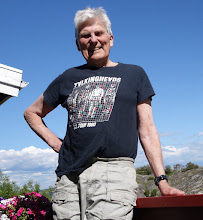I filed my standard comment noting that as far back as 1955 the Times reported that Green Energy was about to sweep through New England in the form of heat-pump technology. Never happened, and the Times almost never used those two words - heat + pump - together again. In my comment I point to the technology that is at its most advanced level in Sweden and Denmark as shown in the post below this one.
The goal of an ideal Green New Deal would be to make whole neighborhoods kept warm, well lighted, and even cool using 100% renewable systems. My neighborhood here in Linköping, called Valla, provides full-scale examples of how meeting such a goal might be met.
Best is the brand new wooden apartment building, Berså, about 500 meters from my home. I visited Berså this morning and introduce this Green New Deal building to readers today. I will be contacting the Linde Company, builder, to obtain technical information.
Valla Berså apartment building, Linköping SE. The goal in creating this building was to illustrate how far it is now possible to approach the goal of 100% renewable. The roof is covered by solar panels, and an electronic display at the main entrance shows how much electricity was produced by these panels each day. The building itself hides 10 boreholes, each about 200 meters deep, that provide the basis for the ground-source geothermal heat-pump system (GHSG) that heats this building now and that will cool it whenever even in Sweden the temperature calls for space cooling. Here is one of the displays that I will from now on monitor regularly.
I believe this shows daily solar energy production but cannot provide exact information until I have made contact with a technical representative at the Linde Company. What interests me most is to learn in detail how much heat is delivered to the building each day by the GSG system and ultimately to compare the efficiency of that system with the efficiency of the solid-waste incineration system that delivers heat to all the buildings that surround Valla Berså including mine. The next picture shows how you can tell that my home is heated by "fjärrvärme"/distance heating.
Snow fell last night and covered the ground completely, even my front yard shown here. But there is a pipe buried under my front yard that connects to the pipe that feeds hot water to my neighbor, a pipe installed several years before mine. Today, with temperature outside 0 C, water flowing in the pipe enters a small white box in my basement at a temperature of 80 C. A heat exchanger system draws heat from that incoming supply and heats water in two systems, one the radiator system that heats my home, and the other the system that delivers hot water to bathrooms and kitchen. The whole system is silent and the best I have ever experienced.
Next door on the other side is the one home on the street that does not use fjärrvärme but instead has GSG. The previous owner of that home was an engineer who got permission to have a GSG system installed about 10 years ago. That system is of course invisible, there is a borehole about 120 meters deep that contains the tubing through which fluid circulates to capture heat from the bedrock and bring it into the basement to keep that home just as warm as mine. The engineer told me when he was moving that the system had functioned perfectly for those first 10 years and with maximum efficiency.
Last but not least are the solar panel installations that have been spreading on top of older apartment buildings across the street from me and are becoming ever more common on new buildings including the newest here in Valla. Here are the newest installations on an older building.
The solar panels are covered by a dusting of light snow and feed electricity to the integrated system also fed by the local network. Out in the farm country north of where I live there are vast solar panel systems on farm buildings and often close by giant wind turbines supplying electricity for the large dairy farms that dominate in the plains of Östergötland.
Back in the New England I visit every summer I still see old-fashioned oil trucks delivering to homes, propane tanks in back of homes, and natural gas pipelines tearing up the landscape and occasionally providing the fires and explosions that wracked Lawrence and Andover MA a while back.
I prefer silent renewable and you would too if you had access to it.





